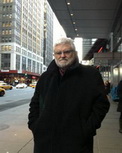 Chris
McDonnell, UK
Chris
McDonnell, UKchris@mcdonnell83.freeserve.co.uk
 Chris
McDonnell, UK
Chris
McDonnell, UK
chris@mcdonnell83.freeserve.co.uk
Previous articles by Chris Comments
welcome here
August
2, 2017
The
marking of ground

Burial grounds have a long history, not always humorous to recount. They range from the small village churchyard where a cluster of plots mark the resting place of generations of families who have spent their entire lives living and working in the clustered houses, to the vast sprawl of city cemeteries.
The day of burial brings together family and friends to celebrate a life and determine a conclusion to this earthly pilgrimage. With the erection after a few months of a stone to mark the spot, the turned earth is visited over the years, flowers are laid and memories held precious.
Philip Larkin, who wrote the poem 'An Arundel Tomb' concludes it with these words.
Time has transfigured them into
Untruth. The stone fidelity
They hardly meant has come to be
Their final blazon, and to prove
Our almost-instinct almost true:
What will survive of us is love.
For an agnostic, Larkin comes to a Christian conclusion, the survival of love.
We attempt to keep fragments of lives before us in the words we inscribe on tombstones. Phrases of favourite prayers, sayings of hope and on occasions a touching humour. Possibly most famous are the words written on the stone of Spike Milligan, who is buried by St Thomas's Church in Winchelsea.
It bears the message 'I told you I was ill'. In order to achieve approval by the Chichester diocese, it is written in Gaelic.
It now has inscribed the words "Duirt me leat go raibh me breoite". Powerful, honest words indeed.
But with greater and greater mobility, families and friends move away from final resting places. Unless arrangements are made for upkeep, it is all too easy for plots of ground to fall into an overgrown and neglected state. Stones surrounded by weeds lose their impact, weathered over the years, the once-sharp letters become illegible and significance is lost. There is a strong case to consider cremation as a sensible and realistic option.
One cemetery in London, Highgate, has Grade 1 listing with over 53,000 graves and some 170,000 burials. It is famous for being the last resting place of a certain Karl Marx. Two famous writers are buried in Paris, Samuel Beckett and Oscar Wilde, the latter resplendent with a tombstone carved by the sculptor Jacob Epstein. Seamus Heaney whose fourth anniversary falls this coming September, is laid to rest in his native Bellaghy in County Londonderry. His tombstone is inscribed with lines from one of his poems, 'The Gravel Walks'. It reads: "Walk on air against your better judgement."
The soft rock under Rome, allowed the development of the Catacombs, carved niches for those who had died and places of refuge in time of persecution. Wall paintings bear evidence to that early Christian occupation and to the celebration of the Eucharist deep in the underground passageways and enlarged spaces. When visiting Rome a few years ago, a group of us were able to share the Eucharist in one such place, a significant and moving experience.
Our liturgy offers a familiar and secure framework for marking the passing of loved ones from this world to the Lord. It has a dignity and serenity that is both gentle and strong. Together we can offer prayers for the relative or friend who has died and at the same time be strengthened in our faith of eternal life.
The sharing of a few words in eulogy need not be serious and sad but can reflect the reality of what we have lost and that may well (and often does) include moments for shared laughter.
Nationally, it can be a moment of significant pause, when someone of great stature and fame has died. It becomes the collective point of grief, a time of recognition and remembrance. Yet even such occasions have their humour. Standing on Ludgate Hill on a cold January morning at the end of the month, in 1965, Anne and I waited for Churchill's cortege to approach St Paul's. A couple of hours before it was due, a truck heaped with sand drove slowly up the hill. Men with shovels threw the sand on the road, others with brooms spread it to help the horses get a grip. One got in the way of the truck and the driver's London voice was heard calling out 'What you tryin' to do mate? join him?'. The packed pavements responded with a ripple of laughter.
The funeral, as well as being a social occasion for those attending, is of course one of the 'marker points' of church attendance, however sporadic contact might have been in previous years. The final coming together is a moment of forgiveness, making tidy the inherent untidiness of many lives.
That is as it should be, with all of us dependent on the ultimate generosity of God.
END